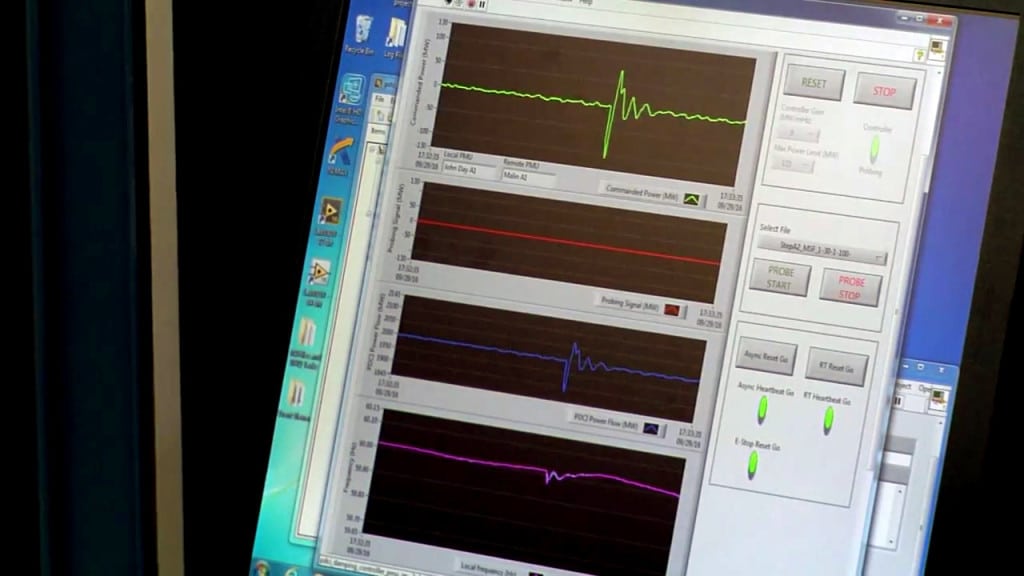Decade-Old Power Grid Problem Solved by Smart Grid Technology
A control system that smooths out inter-area oscillations—a problem affecting power systems connected by relatively weak tie lines—has been successfully demonstrated by researchers from Sandia National Laboratories and Montana Tech University. The system that uses smart grid technology could allow utilities to push more power through transmission lines, possibly nixing the need for new transmission lines and help to stabilize the grid.
Electric power grids operate well below transmission capacity to avoid widespread outages due to inter-area oscillations, which occur when the standard frequency of 60 cycles per second increases on the utility side of the transmission line while the frequency on the customer side decreases, switching back and forth every second or two. “Most of the time these oscillations are well-behaved and not a problem—they are always there,” explained Sandia engineer David Schoenwald. “But at a moment when you are trying to push a large amount of power, like on a very hot day in the summer, these oscillations start to become less well behaved and can start to swing wildly.” In August 1996, for example, such oscillations became so strong, they split apart the western power grid, isolating the Southwest from the Northwest, and resulting in a large-scale blackout spanning eight states.
To date, the only safe and effective way to prevent disruptive oscillations has been to reduce the amount of power sent through a transmission line. While scientists have known about inter-area oscillations for more than 40 years, damping (or controlling) them has been elusive, owing to a lack of real-time measurement data throughout the grid.
“For the last 21 years, utilities have handled these oscillations by not pushing as much power through that corridor as they did before. Basically, they leave a lot of potential revenue on the table, which is not ideal for anyone because customers have needed to find additional power from other sources at a higher price,” said Schoenwald. Sandia noted that an alternative solution for sending more power is to build new transmission lines, “which cost about $10 million per mile and take more than 10 years to build and deploy.”
The new control system developed by the researchers with funding from the Department of Energy and the Bonneville Power Administration is praised widely as the “first successful grid demonstration of feedback control.” As Schoenwald explained, it works to smooth out the inter-area oscillations on the alternating current (AC) corridor by modulating power flow on the Pacific direct current (DC) Intertie, which is an 850-mile high-voltage DC transmission line that runs from northern Oregon to Los Angeles and can carry 3,220 MW of power. Essentially, the system determines the amount of power to add or subtract to the power flow using real-time frequency measurements from sensors (phasor measurement units) installed throughout the western power grid (Figure 1). Every piece of data has a GPS timestamp, and it becomes obsolete if relayed later than 150 milliseconds. The control system then “adds a modulation signal on top of the scheduled power transfer on the [Pacific DC Intertie], which simply means that we can add or subtract up to 125 MW from the scheduled power flow through that line to counter oscillations as needed,” Schoenwald said.

Sandia demonstrated the system on the western grid during three recent trials in September 2016, May 2017, and June 2017 using controlled disruptions. The demonstrations verified that the controller successfully damps oscillations and operates as designed. According to Sandia Manager Ray Byrne, now that the first wide-area damping control of a power system has been demonstrated in the U.S., Sandia’s next step is to design control systems that can simultaneously damp multiple inter-area oscillations on various modes throughout a large power system. The control system could also be eventually replicated for use on other high-voltage DC lines in the future, and components of the system such as the supervisory system could be used for future grid applications.
—Sonal Patel is a POWER associate editor.